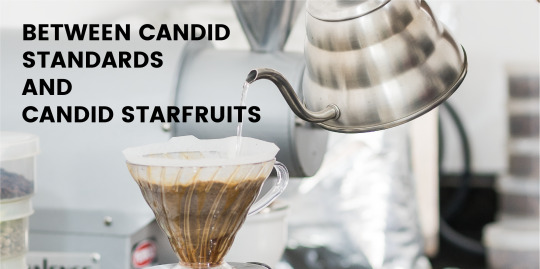In the past two parts of this blog series on coffee evaluation, we focused mainly on the scoring of coffee in numbers. The score of a coffee has huge importance in our industry. It is the benchmark for pricing and reflects the quality of a coffee for most of us. But how much can we really take away from a final score?

It doesn’t tell us much about the character of a coffee and whether you ’re looking for a blend component or just an amazing coffee for your special line: A coffee evaluation has to deliver more than just a number. Most scoresheets leave room for descriptors and demand the cupper to take notes on the scored attributes, but these seem rather secondary in the system of a cupping sheet.
It is fascinating to see that a group of people tasting coffee on a regular base can be as close as 0.25 points in the individual scores, which means they are very calibrated. Linguistic description, however, is much harder to calibrate on as we don’t really have a concise system to articulate flavor. Do you also find yourself using completely different words to describe a coffee than someone else despite being generally quite calibrated to each other? For all those who aren’t sure what I mean, I recommend trying the following experiment. All you need is some ambitious spoon swinging friends and a table of coffees you cup together:
Put three different coffees on the table of which at least two are unfamiliar to you. (if everyone brings one coffee the others don’t know, it should do the job.)
Instead of scoring the coffees with numbers, try to write a protocol of your natural procedure of analyzing the coffee. Write full sentences and be as precise as possible.
Then read out your description to each other and compare the individual attributes but also the structure and order of the evaluation.
Most likely you will find that some descriptors of aromatics are matching. When you taste a fruity Kenyan SL-34 all of you will identify some “berry” notes. (Blackberry, Gooseberry, etc.)
What you will realize though is the inconsistent order and the large variance in words when it comes to anything else than flavor notes. In our case, some of us didn’t take notes about the intensity of core attributes. Others had no remarks on the balance while someone else wrote almost solely about the acidity.
We also noticed that the style of wording was strongly influenced by our professional background. Roasters would refer much more to sweetness with a different set of words than former baristas or green coffee buyers respectively. What we paid attention to when cupping was quite different even though the coffees we tasted were the same. To put it in a different context. If we put the three coffees on a larger cupping table and handed the notes to someone asking this person to match it with the corresponding coffees… well. The result would have shown a strong unalignment. However, it was also enlightening. We came to two realizations.
Number One: Everyone has their own way of analyzing a coffee. Even though it can result in a numerical rating and the association with learned words, which corresponds to the assessment of your fellow cuppers, the patterns which we use to arrive at this result are highly individual.
Number Two: Using a similar vocabulary is insufficient if you don’t put it in the right order, because it produces blindspots. Any language is made of words and grammar. If words were the bricks, grammar is the mortar. Without the mortar, the wall falls apart.

The journey of tasting a coffee
How do you cup coffee? What goes on in your mind when you do? Isn’t it a fascinating mental process?
Even though this is such an essential matter in our industry there is yet very little content about the actual procedure of tasting. The most common literature deals either with the color and shape of mugs or with the biochemical aspect of taste perception. It goes a bit along the lines of this:
Different volatile chemicals rise up to your nasal cavity to stimulate the olfactory perceptors which then send electric signals to the gustatory cortex were the information is processed.
Some good buzzwords here and there and you seem to have a sound explanation of how humans perceive taste and aroma.
Indeed it is, but it is the answer to the wrong question.
It explains how the how the information gets to our brain, but not how we process it once we obtained it. This is where taste psychology and the tricky aspects of conditioning and framing come into play.
Early fundamentals of taste psychology have already emerged in ancient Greece when philosophers like Plato put their mind to how we process the impression from what we put in our mouths. He first lexicalized the basic tastes like sweet, sour, bitter and salt, which have become totally intrinsic to our understanding of taste.
Yet what I would like to raise the awareness for in this blog post is how a concept of taste, may it be as simple as the one introduced by Plato, influences the way we perceive coffee and express its perception.
How would you describe the character of a coffee if no one ever showed you how to do that? It is a big challenge for newcomers in coffee to “find the right words” to describe a cup of coffee. In the beginning, we all listened carefully what those who seemed proficient would say. We learned words like juicy or bright and so when someone asked you the next time what you thought, you probably fired out the few words you learned last time. Every coffee you liked was juicy. Every cup you didn’t like was astringent. What a nice word: Astringent. I liked this one a lot when I started in coffee. It sounded sophisticated. Bitter, Roasty, Musty, Dry, Tart = Astringent.
The journey of tasting a coffee is influenced strongly by the concepts and ideas out there. The most significant one is surely the SCA cupping protocol and the ideas that led to it. Many of us refer to it more or less consciously when making the effort to taste coffee in an organized manner.
What the little experiment explained above shows, is that we all use a different chronology of attributes as we cup. What do you best start with? Aromatics, because they appear first on many scoresheets and we have internalized this procedure to a great extent? Acidity, because it is the anchor of quality for most cuppers? Overall impression regarding cleanliness and balance, because getting a general impression in the first round of tasting seems to be a logistical step? Not easy…
The context in which we cup will also dictate how we approach a coffee. Roasters, for example, think a lot about ratios. They are aware of the given potential in a green coffee and try to define the right amount of development to create a taste experience to their liking. Therefore balance would be much more a point of focus here with a different meaning than in green coffee evaluation.
When cupping for green analyzes, the scope must be generally a lot wider. Green coffee cuppers look for taints in a coffee more than anything and on top of this try to estimate the potential of the coffee for a later purpose. When tasting green coffee one has to look through aspects like brewing and roasting despite their huge effect on the cup experience in order to get to the relevant field of work. First and foremost this will be related to the happenings at the farm level like the choice of variety, the cherry ripeness, fermentation, drying and so on. The core attributes are cleanliness, acidity, and aromatics.
Another field in which coffee is tasted frequently is in the preparation of coffee as a final beverage. Here the point of reference is the cup as a whole rather than single aspects. The job of a barista is to look at the cup as it really is and to imagine the experience of the customer, hence the overall impression is more significant. When going into detail, they put the focus on bitterness and dryness (aftertaste and mouthfeel) as they determine the limitation of extraction and also on the level of acidity as it is the sensorial ceiling of the brewing strength.
Coffee Cuppers Syntax
These few examples show already how impalpable the character of coffee is and why we are inconsistent in the expression of taste.
Despite (or maybe because of?) this circumstance I believe that an effort to structure our words better will lead to a more constructive conversation around the cupping table.
Therefore I would like to suggest some guidelines that can help anyone at any level of tasting to have a more structured approach. In fact, these quite intuitive rules have proven to work well in competitions and other beverage industries.
Just have a look at wine! The degree of systematization is simpl impressive. If you are curious what it is like to describe a wine like a pro, check out this video!
(Obviously, wine is a much more stable product with a uniform way of presentation and the variation from one bottle to another of the same wine is marginal.)
From General to Specific
As mentioned before: There is always a certain purpose of the cupping and usually, it involves the decision whether or not a coffee qualifies for the intended use. For example, the SCA specialty coffee form is a tool to identify specialty coffees. The general criteria for this are:
- Presence of sweetness
- Uniformity
- Cleanliness
In this case, one should start by saying whether or not the coffee qualifies as specialty grade.
The coffee is sweet, clean and uniform.
What follows will go more and more into depth, describing the coffee more specifically.
This rule should be followed also in the individual attributes. Mention first the overall, broad category and then become more specific if possible. For the aromatics, it would go like this:
Fruity. Stonefruit-like. Yellow stonefruit. Apricot. Dried apricot. Dried apricot skin.
This doesn’t mean one should always have such a detailed list of descriptors. Most coffees don’t show very specific flavor attributes such as dried apricot which is why one should rather use the more general descriptor if the cup as such isn’t replicable. This reflects also in the coffee flavor wheel were the attributes become more specific from inside to outside.
From High to Low
The high-to-low-rule relates mostly to the intensity. When describing a single attribute like flavor one should start with the notes of highest intensity followed by the lower ranking notes.
Flavor notes in a coffee can be broadly separated into three categories which were presented first by the head of sensory analyses at Cafe Imports, Ian Fretheim, who developed a new cupping form.
These are Fruity, Floral, and Caramel. Always go with the most intense category first and then work from the attribute of the highest to the lowest intensity.
The coffee is medium-high in fruit aromatics.
- Stone-fruit (highest)
- Citrus (medium)
- Berries (lowest)
From Absolute to Relative
Attributes can have an absolute or relative character. Absolute means that the attribute is quantifiable, hence it could be measured. Relative attributes are more metaphorical (“it is like…”) and are more context-based than factual.
The acidity attribute can make this very clear. We first start with an assessment of the intensity.
The acidity is medium high.
This assessment is done on a scale rating from the lowest possible amount of acidity (0) to the highest know intensity (10). Through calibration, one could make this assessment with very high reliability.
A similar degree of certainty is provided by the type of acid.
The acidity is citric.
There is a quantifiable amount of citric acid in a cup of coffee which can validate this description. The same will go for all other physically present acids in the coffee.
When the absolute character of an attribute is fully assessed one can proceed with relative descriptions which involve some degree of creativity and are more individual as they are linked to memories.
The acidity reminds me of rhubarb.
What kind of rhubarb? Ripe or Unripe? With sugar or without? Such expression can be valuable when the context is clear but one should be aware of how ambiguous such a description is . Generally, you should be rather reserved when the assessment has to be repeatable in a different time and place and across different cultural backgrounds.
Describing coffee is fun but also difficult. I hope that the ideas of this blog series are helpful and nurture some new conversations at your cupping table. At the algrano cuppings, we constantly challenge our concepts and try to become better at tasting coffee. If you want to cup with us, swing by at our office or check out our social media channels for public cuppings across Europe!




Let Us Know What You Thought about this Post.
Put your Comment Below.